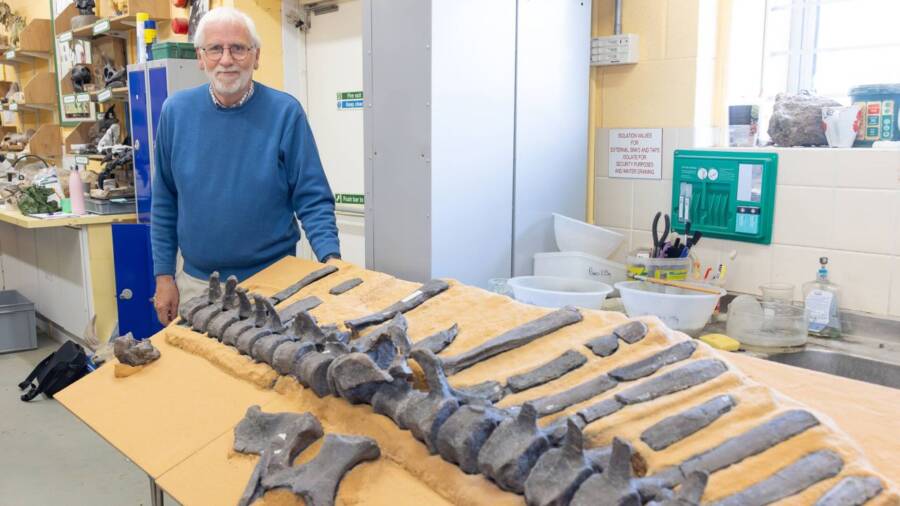Istiorachis macarthurae likely used its unique sail to attract mates or intimidate other dinosaurs.

James Brown/University of PortsmouthIstiorachis macarthurae is a newly-identified dinosaur species that was initially unearthed on the Isle of Wight in the 1970s.
A fossil that was found on the Isle of Wight nearly 50 years ago has just been identified as a previously unknown dinosaur — and it had a particularly unique feature.
Istiorachis macarthurae, which lived 125 million years ago, had a massive sail down its spine that likely aided with muscle attachment or was used to attract mates. Because of this, the dinosaur was named after Dame Ellen MacArthur, who became the fastest person to sail around the world nonstop in 2005.
The Dinosaur’s Unique Sail Set It Apart
The remains of Istiorachis macarthurae were first uncovered by fossil hunter Nick Chase in the 1970s. At the time, paleontologists believed the bones belonged to one of the two known species of Iguanodon that lived on the Isle of Wight. It wasn’t until Jeremy Lockwood, a retired physician pursuing his doctorate in paleobiology, recently took another look at the fossils that he realized the spine didn’t quite match other iguanodontian dinosaur bones previously found on the island.
“It was thought to be just another specimen of one of the existing species, but this one had particularly long neural spines, which was very unusual,” Lockwood told the BBC.

University of PortsmouthLockwood with the fossilized remains of Istiorachis macarthurae.
After re-examining the existing collection of Iguanodon remains, as well as reviewing papers written about members of the genus, Lockwood determined that these bones were from a different species altogether — one that hadn’t been discovered yet.
What set this new species apart was a sail that ran along its spine. These types of dorsal sails are rare, but not unheard of. There are select species of reptiles today, such as crested chameleons and sail lizards, that have a similar feature.
“Partly, we think this was for muscle attachment,” Lockwood explained. “Iguanodontians were changing from small bipedal dinosaurs into much bigger animals that spent more time on four legs, so they would have needed stronger muscular support for their backbones.”
And in a study Lockwood published in Papers in Palaeontology, he suggests the dorsal sail may have been used for signaling, similarly to how peacocks display their feathers to potential partners. “Sexual signaling is the most probable explanation,” Lockwood stated. “When a characteristic is exaggerated beyond its practical function in living animals, it is invariably due to the evolutionary pressure to attract a mate.”
This sail is also what gave I. macarthurae its name.
Dame Ellen MacArthur, The Namesake Of ‘Istiorachis Macarthurae’
The inspiration for the name Istiorachis macarthurae came from British sailor and Isle of Wight resident Dame Ellen MacArthur. In 2005, she became the fastest person to sail around the world without stopping, traveling 27,354 miles in 71 days, 14 hours, 18 minutes, and 33 seconds.

Amplified Group/Wikimedia CommonsDame Ellen MacArthur, the sailor Istiorachis macarthurae was named for.
“The fact that the Istiorachis ‘sail’ could be likened to the sails I have spent so much of my life below was very touching,” MacArthur said. “It is certainly not an everyday occurrence to be asked if a newly discovered dinosaur could reference your name in its title.”
The discovery of I. macarthurae may be teaching scientists more about the species that roamed the Isle of Wight hundreds of millions of years ago, but there is still plenty they don’t know.
“The discovery of another iguanodontian from the Isle of Wight shows that this was a very diverse area in the Early Cretaceous,” Lockwood said. “I’m sure there’ll be more discoveries in the years to come.”
After reading about the discovery of Istiorachis macarthurae, learn about the Quetzalcoatlus, the largest flying dinosaur to ever live. Then, take a look at these 31 dinosaur facts you probably didn’t know.





